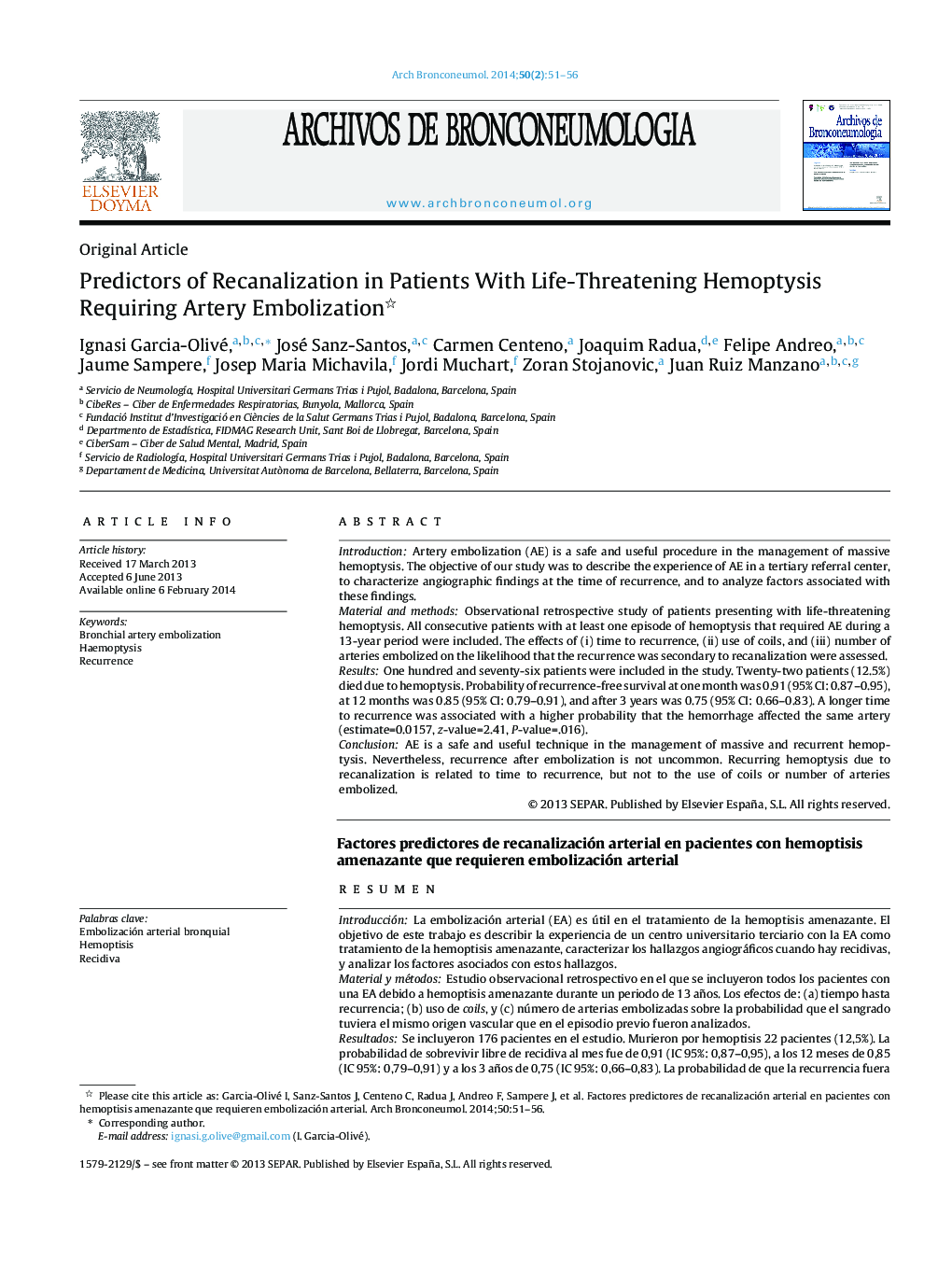| کد مقاله | کد نشریه | سال انتشار | مقاله انگلیسی | نسخه تمام متن |
|---|---|---|---|---|
| 4205681 | 1279926 | 2014 | 6 صفحه PDF | دانلود رایگان |
IntroductionArtery embolization (AE) is a safe and useful procedure in the management of massive hemoptysis. The objective of our study was to describe the experience of AE in a tertiary referral center, to characterize angiographic findings at the time of recurrence, and to analyze factors associated with these findings.Material and methodsObservational retrospective study of patients presenting with life-threatening hemoptysis. All consecutive patients with at least one episode of hemoptysis that required AE during a 13-year period were included. The effects of (i) time to recurrence, (ii) use of coils, and (iii) number of arteries embolized on the likelihood that the recurrence was secondary to recanalization were assessed.ResultsOne hundred and seventy-six patients were included in the study. Twenty-two patients (12.5%) died due to hemoptysis. Probability of recurrence-free survival at one month was 0.91 (95% CI: 0.87–0.95), at 12 months was 0.85 (95% CI: 0.79–0.91), and after 3 years was 0.75 (95% CI: 0.66–0.83). A longer time to recurrence was associated with a higher probability that the hemorrhage affected the same artery (estimate=0.0157, z-value=2.41, P-value=.016).ConclusionAE is a safe and useful technique in the management of massive and recurrent hemoptysis. Nevertheless, recurrence after embolization is not uncommon. Recurring hemoptysis due to recanalization is related to time to recurrence, but not to the use of coils or number of arteries embolized.
ResumenIntroducciónLa embolización arterial (EA) es útil en el tratamiento de la hemoptisis amenazante. El objetivo de este trabajo es describir la experiencia de un centro universitario terciario con la EA como tratamiento de la hemoptisis amenazante, caracterizar los hallazgos angiográficos cuando hay recidivas, y analizar los factores asociados con estos hallazgos.Material y métodosEstudio observacional retrospectivo en el que se incluyeron todos los pacientes con una EA debido a hemoptisis amenazante durante un periodo de 13 años. Los efectos de: (a) tiempo hasta recurrencia; (b) uso de coils, y (c) número de arterias embolizadas sobre la probabilidad que el sangrado tuviera el mismo origen vascular que en el episodio previo fueron analizados.ResultadosSe incluyeron 176 pacientes en el estudio. Murieron por hemoptisis 22 pacientes (12,5%). La probabilidad de sobrevivir libre de recidiva al mes fue de 0,91 (IC 95%: 0,87–0,95), a los 12 meses de 0,85 (IC 95%: 0,79–0,91) y a los 3 años de 0,75 (IC 95%: 0,66–0,83). La probabilidad de que la recurrencia fuera debida a una afectación de la misma arteria dependía del tiempo hasta la recurrencia (estimado = 0,0157, valor de z = 2,41, valor de p = 0,016).ConclusiónLa EA es efectiva en el tratamiento de la hemoptisis, pero las recidivas no son infrecuentes. La recidiva del sangrado por recanalización de la arteria embolizada está relacionada con el tiempo transcurrido hasta la recidiva, pero no con el uso de coils ni con el número de arterias embolizadas.
Journal: Archivos de Bronconeumología (English Edition) - Volume 50, Issue 2, February 2014, Pages 51–56
